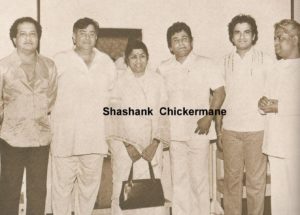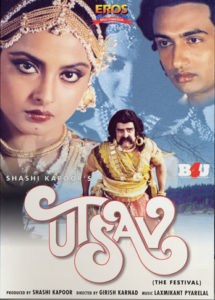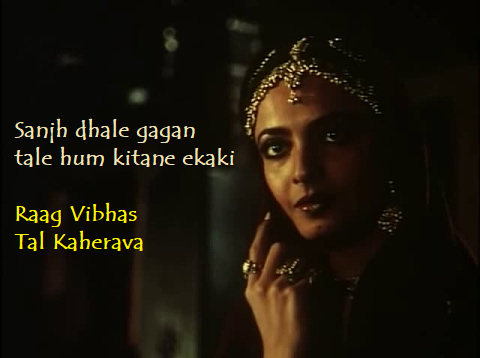Raaga Based Song of the Day: Sanjh dhale gagan tale hum kitane ekaki….
Raag Vibhas, Tal Kaherava

Well, another new Raag today. Three days ago, when I put up a list of Raagas, you would have noticed one spelt Vibhas at one place and Bibhas at another. That’s the raag that Laxmikant Pyarelal used for composing two of the four songs in the 1984 Girish Karnad movie Utsav, a Shashi Kapoor production. Suresh Wadkar sang it.
We have completed sixty-eight days of Raaga Based Songs of the Day. Our first post in the series was titled ‘Raaga Based Song Of The Day #1’ and the song was a Mohammad Rafi and Lata Mangeshkar song from the 1970 Shakti Samanta movie Pagla Kahin Ka: Tum mujhe youn bhula na paoge. It is in Raag Jhinjhoti, Tal Kaherava.
Our sixty-eighth post or the last post was titled ‘Raaga Based Song Of The Day #68‘ and the song was a Mohammad Rafi song from the 1958 Bimal Roy movie Madhumati starring Dilip Kumar, Vyjayanthimala and Pran: Toote huye khwaabon ne. It is in Raag Darbari Kanada, Tal Kaherava.
This blog has a number of posts on Raaga based songs in Hindi movies titled similarly; for example: ‘The Best Raaga Based Songs in Hindi Movies – Raaga Jhinjhoti – Part II‘.
In the last sixty-eight days of sharing Raaga based songs of the day, I have given you songs based on Raag Jhinjhoti, Gara, Bhimpalasi, Madhuvanti, Shivaranjani, Bihag, Pahadi, Sarang, Pilu, Bhairavi, Khammaj, Charukesi, Kalyan or Yaman, Desh, Malgunji, Kirwani, Kedar, Bageshri, Megh Malhar, Bhupali, Ahir Bhairav, Malkaush, Mand, Adana, Kafi, Rageshri, Jaunpuri, Tilang, Janasammohini, Chayanat, Shuddha Kalyan, Gaur Sarang, Jogiya, Asavari, Maru Bihag, Durga, Lalit, Puria Dhanashri, Bhinna Sahdja, Sohani, Multani, Patdeep, Jaijaiwanti, Tilak Kamod, Hemant, Basant Mukhari, Gujri Todi, Kalavati, Hamir, Bhatiyar, Gawati, Shyam Kalyan, Gorakh Kalyan, Madhamat Sarang and Manj Khammaj. The six raagas that have been repeated so far are Pahadi, the raaga of my home place in the Himalayas, Maru Bihag, Raag Kirwani, Jhinjhoti, Bhairavi, and Gara. Today, I am giving you a new Raag Vibhas. That makes it a total of 57 raagas.
Today’s song has been sung by Suresh Wadkar on the lyrics of Vasant Dev and on a composition by Laxmikant Pyarelal. As I said, it is in Raag Vibhas, Tal Kaherava.
However, first, lets take up the value added learning of today. Today, we shall learn about a mobile application to help identify raagas.
This was launched on Independence Day, 2013.
To the untrained enthusiast, Indian classical music can be daunting. Some can’t tell Raag Bhairav from Raag Bhairavi, others can’t tell any raagas at all. Even music students find it challenging to identify complex raagas.
Now, a mobile application launched on Independence Day aims to make raaga identification much easier. The app, called Raga Quest, uses a hangmanstyle game to help users guess the name of the raga being played in a 30-second sound clip.
It has been created by Indian Raaga, a Boston-based company launched in November 2012 to promote Indian classical music through digital technology. The app is available on the iOS AppStore and can be downloaded for free. It can be used on Android phones and Windows phones in addition to iOS.
“Identifying ragas is not something that comes naturally to everyone, but one can get better at it with practice,” said Sriram Emani, 27, co-founder of Indian Raaga and an MBA student at Boston’s Massachusettes Institute of Technology. “The app will be a simpler, fun way to practice raaga identification.”
With a user-friendly interface, Raga Quest can be used for both Hindustani and Carnatic music. Users can pick from a range of difficulty levels, and during the hangman game, can use a raga spelling guide to guess the raaga.
As I mentioned, today’s song is composed in Raag Vibhas, Tal Kaherava.
Raag Vibhas or Bibhas belongs to the Bhairav Thaat (that makes use of Komal Rishab and Komal Dhaivat. Bhairav is one of the names of Lord Shiva especially in his powerful form as a naked ascetic with matted locks and body smeared with ashes). Naturally, it makes one assume that the raag too has some of these masculine and ascetic attributes in its form and compositions. Its Jati is Audhav-Audhav, that is five notes in Aaroha and Avaroha (five notes except Madhyam and Nishad). The time for singing this raag is first prahar of the day, that is 6 PM to 9 PM. As you can make out from the song itself, the raag has a heavy feel to it, perfect for Bhakti Ras.
One other songs composed in Raag Vibhas are: Neelam ke nabh chhayi (from the same movie).

The song Sanjh dhale gagan tale hum kitane ekaki is from the 1984 Girish Karnad movie Utsav starring Rekha as Vasantsena, Shekhar Suman as Charudutt, Shashi Kapoor as Samsthanak, Shankar Nag as a thief named Sajjal, Amjad Khan as Vatsayana, author of Kama Sutra, and Anuradha Patel as Charudutt’s wife Aditi.
There were four songs in the movie. One of them, sung by sisters Lata Mangeshkar and Asha Bhosle became a super-hit: Man kyun behka re behka aadhi raat ko. Another one Neelam pe naabh chhayee was also composed in Raag Vibhas. The song was penned by Vasant Dev who received Filmfare Award for having penned Man kyun behka re behka aadhi raat ko.
Please enjoy in Raag Vibhas, Tal Kaherava: Saanjh dhale gagan tale hum kitane ekaki…
Saa.njh Dhale gagan tale
Ham kitane ekaakii
Saa.njh Dhale gagan tale
Ham kitane ekaakii
Chho.D chale naino ko
KiraNo.n ke paakhii
Path kii jaalii se jhaa.Nk rahii thii.n kaliyaa.N – 2
Ga.ndh bharii gunagun me.n magan huI thii.n kaliyaa.N
Itane me.n Timir dasa sapane le nayano me.n
Kaliyo.n ke aa.Nsuo.n kaa koI nahii.n saathii
ChhoD chale nayano ko
KiraNo.n ke paakhii
Saa.njh Dhale gagan tale …
Juganuu kaa paT o.Dhe aayegii raat abhii – 2
Nishiga.ndhaa ke sur me.n kah degii baat sabhii
Kapata hai man jaise Daalii ambavaa kii
Chho.D chale nayano ko
KiraNo.n ke paakhii
Saa.njh Dhale gagan tale …
We have intended to learn about Raaga based music whilst we entertain ourselves with Raaga based songs. So, lets, once again, take stock of our collective learning so far:
- On the first day we learnt about the Raaga system devised by Pandit Vishnu Narayan Bhatkhande, which is the prevalent system in Hindustani Classical Music and based on ten Thaats.
- On the second day we learnt about Tal or Taal.
- On the third day we learnt about characteristics of Raagas that included Swar, Jati, Thaat, Arohana and Avarohana, Vadi, Samvadi and Pakad.
- On the fourth day, we learnt about Sargam.
- On the fifth day, we learnt about notations used in Indian classical music or simply Swar Lipi.
- On the sixth day, we learnt about the Ras (sentiments) that Raagas evoke.
- On the seventh day, we learnt about various types of Swar: Shuddha, Achal, Vikrut, Komal and Teevra.
- On the eighth day, we learnt the parts of a composition in Indian Classical Music.
- On the ninth day, we learnt the names of some of the popular instruments used in Indian Classical Music.
- On the tenth day, we learnt about the sources of names of Raagas.
- On the eleventh day, we learnt about why Bhairavi is the first raag to be taught to beginners and also why it is the last in a performance.
- On the twelfth day, we learnt about Khammaj Thaat.
- On the thirteenth day, we learnt about Tal Punjabi Theka or Sitarkhani.
- On the fourteenth day, we learnt about Alap.
- On the fifteenth day, we learnt about List of Raagas (Raagmala) in my favourite book: Sri Guru Granth Sahib.
- On the sixteenth day, we learnt about tips for raaga identification.
- On the seventeenth day, we learnt the basics of Gharana system.
- On the eighteenth day, we learnt about Filmi Sangeet.
- On the nineteenth day, we learnt about the commonest Tal in Raagas: Tintal.
- On the twentieth day, we learnt about the Kafi Thaat.
- On the twenty-first day, we learnt a little more in detail about the classification of Raagas.
- On the twenty-second day, we learnt the essential differences between Bhairavi and Bhairav.
- On the twenty-third day, we learnt a little more in detail about the Jati or Jaati of a raaga.
- On the twenty-fourth day, we learnt details of Thaat Bilawal, the most basic thaat in the Bhatkhande’s system of raagas.
- On the twenty-fifth day, we learnt about Tintal.
- On the twenty-sixth day, we learnt in detail about the Raaga – Samay linkage.
- On the twenty-seventh day, we learnt about Lehar.
- On the twenty-eighth day, we learnt about the history of the Hindustani Music.
- On the twenty-ninth day, we learnt about Dhrupad.
- On the thirtieth day, we learnt about Rupaktal that I was introduced to, a few months back, by my friend Anand Desai.
- On the thirty-first day, we learnt about Khayal.
- On the thirty-second day, we learnt about Thumri.
- On the thirty-third day, we learnt about Tappa.
- On the thirty-fourth day, we learnt about Tarana.
- On the thirty-fifth day, we learnt about Tal Dipchandi (Moghali).
- On the thirty-sixth day, we learnt about Tabla.
- On the thirty-seventh day, we learnt about Kirtan.
- On the thirty-eighth day, we learnt about Pakhawaj.
- On the thirty-ninth day, we learnt about Hori.
- On the fortieth day, we learnt about Dadra.
- On the forty-first day, we learnt about Kajri.
- On the forty-second day, we learnt about Chaiti.
- On the forty-third day, we learnt about Sarangi.
- On the forty-fourth day, we learnt about Shehnai.
- On the forty-fifth day, we learnt about Sarod.
- On the forty-sixth day, we learnt about Bansuri.
- On the forty-seventh day, we learnt about Ektal and Tanpura.
- On the forty-eighth day, we learnt about Veena.
- On the forty-ninth day, we repeated our learning of Veena with a small excitement added.
- On the fiftieth day, we learnt about Dilruba/Esraj.
- On the fifty-first day, we learnt about Jaltarang.
- On the fifty-second day we learnt about Qawwali.
- On the fifty-third day, we learnt about Sitar.
- On the fifty-fourth day, we learnt about Surbahar.
- On the fifty-fifth day, we learnt about Harmonium.
- On the fifty-sixth day, we learnt about Santoor.
- On the fifty-seventh day, we learnt about Swarmandal.
- On the fifty-eighth day, we learnt about the Shruti Box.
- On the fifty-ninth day, we learnt about Alankar.
- On the sixtieth day, we learnt about singing in Aakaar.
- On the sixty-first day, we learnt about the Classification of Indian Musical Instruments.
- On the sixty-second day, we learnt a little about Carnatic Music.
- On the sixty-third day, we learnt about Natya Shastra.
- On the sixty-fourth day, we learnt about evolution of musical instruments in India down the ages.
- On the sixty-fifth day, we learnt about Riyaaz.
- On the sixty-sixth day, we looked at a list of Raagas in Hindustani Classical Music.
- On the sixty-seventh day, we learnt about the health benefits of raagas.
- On the sixty-eighth day, we learnt a little more comprehensively about the moods and emotions that raagas evoke.
- And today, on the sixty-ninth day, we learnt about a mobile application to help identify raagas.
There is much more still to be learnt and enjoyed.
Please stay tuned!

Very educative for me
Thank you, Sir.
Shahi Kapoor’s entire career is that of acting in mostly commercial films. Yet ,as a producer he has done exquiste work in producing such films as Junun and Utsav . Song is really excellent, a bhajan type with heavy tone of sadness . Would certainly download the raga app . Earlier tried on lap top to understand raga notes through google lessons but found that too time consumming lengthy and exhaustive procedure.